Westport: Past, Present And Future - Part 2
An editorial series presented by Scoop Amplifier
Part 1 - WHERE - At
the Crossroads in Coaltown
Part 2 - WHO -
The Pain Of "Uncertainty"
Part 3 - WHAT -
Denniston's "Caviar" Of Coal?
Part 4 - HOW -
Hamish Bohannan's Hopes for Westport

Seddonville near where the Mokihinui river meets the sea
Introduction: One way or another it’s a fact that the past, present and future of Westport and the Buller District is inextricably linked to the ground-covered seams and coal-fields on the lofty cloud-draped plateaus directly outside the township’s front door. On the cusp of a weather bomb that hit New Zealand on June 20, Scoop Amplifier paid a 3-day visit to this enduring part of the nation to begin to gain some on-the-spot perspectives into just how steep a battle the majority of Coasters are facing to find ways to tell the story of their intertwined environmental and economic prospects.
Declaration:
Scoop Amplifier's production, travel and logistical costs to
and from Westport in order to produce this series were paid
for by Buller Coal (owned by Bathurst Resources Limited). A
strict protocol for the purposes of editorial freedom was
agreed. Scoop Amplifier is a business unit of Scoop Media.
Please send feedback on this story to WestportStory@scoop.co.nz
The
Pain Of "Uncertainty" - The Westport story, part 2
Local
people speaking up in the Buller
District
Interviews, images and words By Alastair Thompson and Stephen Olsen
“There’s so much uncertainty out there for our town at the moment. This is why people are starting to speak up”.
This sentiment – expressed by a letter writer to Westport newspaper The News on 19 June – was heard often during Scoop Amplifier’s visit to the township in that week.
Uncertainty surrounding the future for Solid Energy’s Stockton mine is one factor concerning the town and district, side by side with uncertainty about plans for Buller Coal’s Escarpment Mine on the Denniston Plateau.
In addition to a forest park and two heritage areas, the Buller District is bounded to the north by the Kahurangi National Park and footnoted to the south by the coastal Paparoa National Park and the world-famous Punakaiki Rocks.
To use the new tagline of the Department of Conservation (DOC), there is a strong sense in which this part of New Zealand shouts out the proposition of ‘Conservation for Prosperity’.
Crudely speaking it’s the bit that’s located between the two National Parks, including further pockets of conservation estate, that is pulling some Coasters apart, at the same time as it is pushing new voices to speak up.
On the one hand there is a legal tug-of-war between coal mining opponents and coal mining proponents that remains caught up in the courts.
Somewhere in the middle of this are community-based interests who call Westport home, and who are uncertain about what will play out next, or who’s calling the shots, or even what courses of action are open to them to speak up, let alone be seen to have an influence.
It seems a common refrain of residents of the West Coast that they are overburdened with views from everywhere but their own home patch.

Westport as seen out of the window of our plane as we arrived - in the center of the image is the Bathurst Resources big blue coal loading facility at Westport dock.
A PEOPLE IN SEARCH OF SECURITY AND STABILITY
Longitudinal data from Roy Morgan Research's single-source survey show that of all NZ citizens “Coasters” identify more strongly as New Zealanders than their urban counterparts at 93% compared to 84% for Aucklanders, and 88% for Wellingtonians.
This may present an aspect of stereotype, but it’s also part and parcel of the reinforcing pressures and expectations put on Coasters by the rest of New Zealand as a resilient people. Traits many New Zealanders would say they aspire to.
Another thing indicated by the Roy Morgan Research across almost 200 attitude-seeking questions put to people on the West Coast is this : it’s complicated, and they have a fairly unique perspective.
The research data captured slightly more women than men. It shows a population who have excelled nationally at higher levels of secondary school and are skilled in their work, though with fewer diplomas or degrees.
A people who are living in communities where as many as half of the households consisted of two people or less, are well represented in the 35 to 49 age group, smoke more, enjoy beer, and go to Church less than the average. More people own or are buying their house on the Coast than for other parts of the country and they are worried about infrastructure like hospital services. They also - perhaps unsurprisingly given the history - have trouble trusting the New Zealand Government.
When it comes to values, West Coast survey responses reveal a people who are first and foremost seeking a stable no-fuss life, anchored to hard working, secure jobs. It may be that this aspiration is created in part by the high levels of uncertainty about their working and financial future which are part and parcel with living in small, isolated rural communities.
West Coaster's are more likely to consider that threats to the environment were exaggerated, but are less optimistic about the future, and strongly agree with the proposition that the gap between rich and poor is growing, and that globalisation brings more problems than it solves.
Finally, and most compelling perhaps, more people on the West Coast agreed with the statement “At heart I’m an environmentalist” (67%) than not - at a level that shaded both Auckland (61%) and Wellington (59%).
A WEST-COAST ENVIRONMENTALIST PERSPECTIVE
Frieda Inta, a mainstay of the Buller Conservation Group and originally from Auckland, definitely sits on the environmentalist spectrum and has been a well-known activist for preserving the conservation estate in the Buller District for many years.
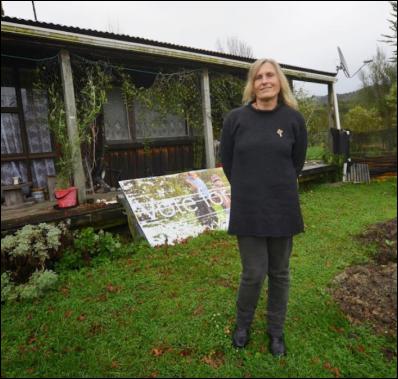
Frieda Inta of the Buller Conservation Society
As a known “greenie” Frieda is no stranger to polarised positions that often surface in letters to the editor; a recent example accusing groups like Forest & Bird of acting in similar ways to any other big business.
She doesn’t take criticism personally. “I have never had anything untoward directed at me, apart from blasphemy”.
On the topic of mining Frieda’s position is that by definition mining is not sustainable and that the conservation values of land should be non-negotiable.
“I’m not totally averse to mines that are open or re-opened, and can see that some efforts at rehabilitation are genuine to a certain extent”.
“A pine forest is being cleared nearby (to Seddonville) and that doesn’t worry me if riparian waterways are looked after”.
Frieda agrees that polarisation is being heightened by a basic tension around the need for jobs in the Buller District. "Mostly what the people of Westport want is jobs".
She also acknowledges that “we all need the things that mining produces” – including the coking coal used in steelmaking – but is skeptical that the true motive is anything but the motive of profits.
"I realize that we all need the things that mining produces and evidently the coal from these mines (helps make) steel which is another method than actually burning it in power plants. And I’m not averse to that because people do need jobs – people in Forest & Bird say that too - but you do have to look after the conservation estate as well".
Youtube Video: Frieda Inta of the Buller Conservation Society
Referring to agreements between DOC and mining company Bathurst Resources she adds, “I’m of the belief that any (environmental) offsetting should be in the same catchment, and anything else is unacceptable”
Frieda is skeptical about the idea of mining and environmental considerations being able to co-exist side by side.
"There’s a lot of destruction that’s gone on on the Stockton Plateau,” she says. “The whole of the Buller plateau is a pretty special ecosystem and a lot of it has already been destroyed in the name of coal. That special ecosystem needs to be preserved.”
A PLACATED AFFECTED RESIDENT
On the highway back towards Westport, Scoop Amplifier met with Tom Baxter, the chair of the Fairdown-Wharatea Residents Association, which has reached an agreement with Bathurst.
Fairdown-Wharatea is an area adjacent to the Plateau and is where any coal mined on the Plateau will need to pass through on its way to its customers.
A relatively new Coaster, having arrived with wife Lyn from Southland in 1985, Tom has worked in engineering and understands the “nitpicking” delays involved before consents are granted. Amongst other jobs Lyn has worked at the town’s information centre and describes Coasters as “pragmatic people”.
The resident association’s opposition to the mining infrastructure planned for the Fairdown-Wharatea area – first proposed by the company that Bathurst Resources bought, L & M Mining – was simple: It was taking the wrong route and would go across land that couldn’t support the infrastructure.
Youtube Video: Tom Baxter, chair of the Fairdown-Wharatea Residents Association
“This was an issue that our association was formed around seven years ago, growing to 106 members with about 95% living here.”
“I take my hat off to Bathurst because they put a better plan together to shift the infrastructure to a location with remnants of an existing footprint, and so we withdrew our opposition. It’s a win-win situation for residents and the environment.”
“They did listen,” says Tom. “There was an antagonistic thing at the start, then we got down and negotiated and made a lot of progress... they really did get stuck in and look for alternatives.”
Without the Escarpment Mine, Tom is certain the Westport economy and town would contract in size, and doesn’t see tourism as a savior. “I think tourism is over-rated, besides which it’s based on burning fuel to get places”.
Tom’s definition of his environmentalism is straightforward: “Coaster attitudes have moved along. The very reason we choose to live here is because of the environment. We like to look after our own backyard, and, at the same time, to make a living. I’d go so far as to say we’ve become the conscience for New Zealand... If only we could put aside being interfered with by everybody else”.
...AND TWO UN-PLACATED AFFECTED RESIDENTS
The conscience of nearby residents Jane and David Orchard was certainly fired up by the original plans for mining infrastructure in their backyard, and despite assurances to the contrary are still fearful of mining activity spreading “closer and closer” to a property they had moved to recently, have planted out in hazelnut trees but would relocate from if given the opportunity.
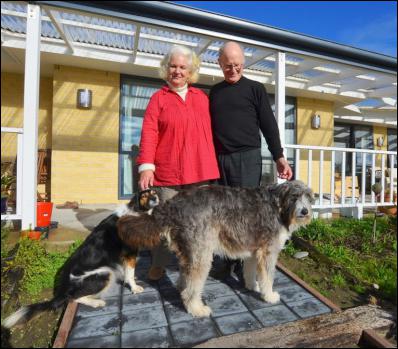
Jane and David Orchard outside their brand new Wharatea retirement home which on an earlier proposal would have been in the same block of land as a planned coal-loading facility for rail transportation of coal to the Port of Lyttelton.
Having both entered their retirement years Jane and David consider that the “Bathurst dream” taken on by many people in the Buller District has supplanted their own dream of an undisturbed lifestyle. In a more colloquial turn of phrase, Jane also equates information that mining companies produce as mere “bullshit and bonhomie”.
One of Jane’s fears is related to health literature on the effects of coal dust and a committed belief she will be in harm’s way. She is equally critical that this hasn’t been highlighted by pressure groups like Forest & Bird. “They’re not interested in people because their mandate is flora and fauna”.
Both Jane and David have seen decades of change on the Coast and can accept that without any other substantial industry, Westport’s reliance on mining is understandable. Their ideal scenario would be for mining that is still “ticking along” to slowly wind down.
David (a retired solicitor) adds: "I still accept that there is a need for coal mining internationally. Although we’ve got to stop the massive CO2 emissions, nevertheless the world can’t survive without steel at the moment".
THE PROSPECTS FOR THE YOUTH OF WESTPORT
One of the questions that an uncertain future for mining begs for local residents is what are the future prospects for young people in the Buller District, those who who are just starting out in the workforce.
Debbie Peters, Shelley Taylor, Ellie Ngatai and Gina Lee-Robertson work at the coalface of youth at the Buller REAP (Rural Education Activities Programme) in Westport’s major thoroughfare Palmerston Street.
They have no doubt of the influence that growing up in a coal mining district has on the career pathways of the young people they work with.
They estimate the percentage of youth with connections to mining is 60% or higher, and they are aware of an exodus to mining jobs in Australia. "If mining didn’t go ahead there’d be planefulls heading for Australia".
“Being in a waiting mode (for new projects) is stressful, and businesses in Westport are holding on by the skin of their teeth,” says Shelley.
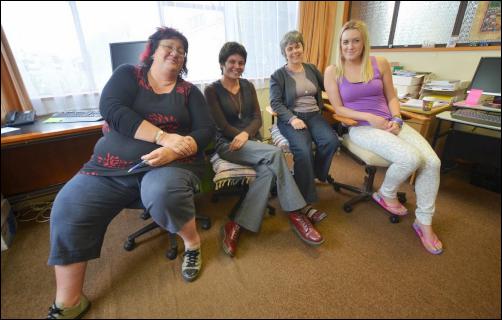
From Left: Debbie Peters, Ellie Ngatai, Shelley Taylor and Gina Lee-Robertson of REAP Westport
The effects of Grey District’s downturn to the south has seen some Greymouth shops drift into Westport, but there are doubts that Westport is thinking ahead about how best to respond to a greater downturn of its own.
While the youth team take some comfort in low youth crime, they’re very aware that choices of career are thin on the ground and that some pathways aren’t geared for locals, like fishing, or, like the Christchurch rebuild, aren’t long-term prospects.
Members of the team like Shelley remember the high unemployment of the 80s and the big shift since then that has lifted people out of poverty.
A strong conviction was expressed that mining jobs “up on the hill” will only work in the interests of Westport if the mining companies aren’t dysfunctional and really invest in the town rather than taking a ‘fly in, fly out’ approach.
This would call for a mindshift towards better planning – such as specific projections on expected job generation – and more practical leadership and vision specific to “our side of the mountains”.
In terms of the role of mining, Shelley observed that a robust number of people, say one in five, "are on the fence about mining but keep relatively quiet".
"Their thinking is they don’t want to be labeled with some extreme views, just because they privately love the environment. A consolation is that there is this amazing regenerative power in the forces of nature on the Coast. There's a point of resignation, hey this is going to look messy for 50-100 years, but it’s going to come back".
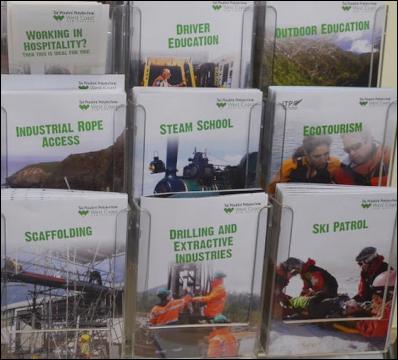
West Coast Careers : a selection courses available at Tai Poutini the main tertiary education institution in Westport
Further along Palmerston Street, the Westport campus of Tai Poutini Polytechnic offers ‘Training on Coast for Coasters’.
Campus manager Marja Kneepkens shares the Buller REAP team’s focus on needing to give young people a “clear direction on our own doorstep”.
As the sole tertiary education provider based on the Coast, Tai Poutini strives to work closely with its stakeholders, evidenced by a strategic forum Marja coordinated in 2011 to help the polytechnic to answer its own questions about the part it can play to enhance the viability of the town and district.
“Eighteen months ago everything (at that forum) was hinged around coal development. Solid Energy was going strong and Bathurst had appeared on the scene and was very vocal on its intentions,” says Marja.
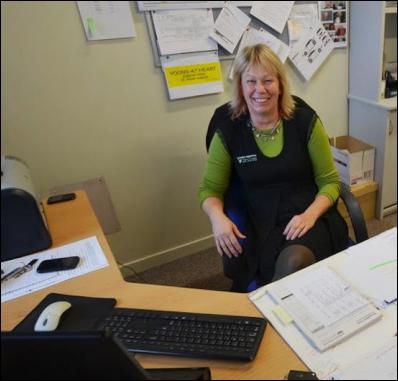
Tai Poutini Polytechnic Campus manager Marja Kneepkens
“The community has definitely been rocked by what’s happened to Solid Energy and the Bathurst court arguments have dragged out a lot further than initially expected. Confidence about growth in mining is still there even though it’s been challenged a little bit. That’s the basis on which the polytechnic made a commitment to invest".
“Unemployment still appears to be low but what we have now is a lot of nervousness. The retail sector is starting to hurt, and while there are still housing developments going ahead, something needs to change”.
Similarly to Tom Baxter, Marja – an active recreational caver – isn’t convinced that tourism can deliver substitute jobs. “There are pockets of opportunity but we can’t hinge our future on those, we need something more tangible. Any district needs some key industries as its reason for being".
Tai Poutini’s next ambition in and for Westport is to open a new trade training facility.
In the meantime a first cohort of engineering students will be training at a workshop space made available by local firm Kernohan Engineering, in what Marja describes as a “fabulous example of education and industry working together”.
She also senses some parallel between the pragmatic compromises and environmental sacrifices involved in the pursuit of caving vis-à-vis achieving a balance between economy, education and environment that can accommodate coal mining.
ENVIRONMENT WEST COAST - A NEW VOICE FOR THE WESTPORT COMMUNITY
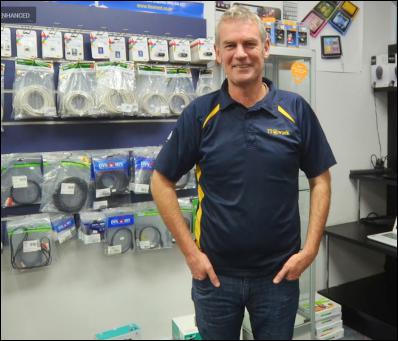
Environment West Coast's Brent Oldham
While it might not constitute a fully fledged boil over, the strongest symptom yet of frustration in the Westport community has seen the formation of a new group in May 2013, calling itself Environment West Coast (EWC).
When EWC first emerged on the scene, Westport’s daily newspaper featured interim chairman Brent Oldham, who runs local business IT@Work on the main street, under the headline “Hands go up for EWC”.
The coverage set out EWC’s intent to set itself up as a charitable trust and made its desire to occupy the middle ground on the debate on mining readily apparent.
According to the original article Buller people had lost patience over the latest Forest & Bird appeal against the Escarpment Mine and had seen the need to somehow counter the fact that Forest & Bird is “media savvy, had superior funding, significant membership, and had claimed the moral high ground”.
Chief reporter Lee Scanlon reported the group’s inaugural meeting attracted 170 supporters, and that rather than being an exercise in “greenie bashing” there was an acknowledgement that work done by Forest & Bird, and the wider green movement to highlight, mitigate and champion environmental issues, had resulted in significant positive changes for the region.
Speaking to Scoop Amplifier, Brent Oldham says he regrets that a group like EWC had not been set up years ago “to be a player in the debates about development on the Coast”. He is well aware any new group perceived as a lobby group could “get picked off if it gets into extremes of debate”, and is taking great pains to walk a tightrope down the middle, while staying true to a Westport-based perspective.
From Oldham’s point of view, coal is a West Coast asset that’s accessible even while agreeing that the area is owned by all New Zealand.
“For us, it’s easy to get, we’ve got tonnes and tonnes of it, it's desired around the world and it’s valuable,” he says. “However, its perception by the rest of New Zealand is it's a dirty industry that contributes to global warming and everything else. If we can get the truth out there as to what that coal is used for, and why it’s dragged halfway across the world, I think peoples’ opinions will change.”
Oldham’s of the view that there can be a balance between locking up land and exploiting resources. He pulls out some numbers to support his contention.
“If you look at the West Coast area, there’s 23 and a half thousand square kilometres roughly, with 19 thousand square kilometres in DOC estate – so we’re playing on four and a half thousand square kilometres for forestry, agriculture, the communities, everything else,” he says. “The mining footprint on the West Coast is 14 square kilometres; it’s tiny.”
The EWC strategy, set out on its website, is to “force discussion into a wider arena” but without inviting confrontation. Remaining “calm and steady” is a fine line to tread which will make EWC a group to watch, especially given its uphill call to “remove emotion, present only facts” is emblematic of a tall order that dogs similar situations everywhere: How to balance support for measurable development of a finite resource without becoming divided into irreconcilable camps.
“At our first public meeting I stood up and made the point that our region is far better off for the efforts that the conservation movement have put into it. We live in one of the last bastions of untouched ecology and we owe it to ourselves to the generations to come and the rest of New Zealand to look after it as best we can,” says Oldham.
“But we can’t look after it if we’re not earning money, if there aren’t people here to support the infrastructures, the hospitals and the schools and the roads. At the moment the only way we’re going to do that is by extracting some of those resources. And the fact that those resources are there, and there in abundance, they’re very nearby, and the rest of the world wants them and they’re going to pay a premium for them; why not?”
Youtube Video: Environment West Coast's Brent Oldham
Other figures in the Buller business community include driven entrepreneurs such as Mark McIntyre of Johnsons Transport.
Mark’s company employs 80 people, has just invested in a new depot in Westport’s Stafford Street worth $2.5 million and celebrated 50 years of continuous business on the 13th of July.
An import to the Coast from Nelson, Mark is fond of the commonly used term “black gold” for coal, noting that for his own firm the trucking work associated with rehabilitation of mined land is starting to create almost as much work as extracting the coal.
He’s a savvy businessman used to coping with variability and with a diversified range of activity that tends to reflect overall gross spending figures on the Coast for last year: $629 million on mining, $425 million on dairying and $142 million in tourism. Next to the revenue streams generated by coal, cows and conservation, the other mainstay of his business is trucking cement-related loads for the Swiss-owned multi-national Holcim and its major plant at Cape Foulwind.
A DOCK, A BIG SHED, BUT NO COAL, YET
Cement-related cargoes are also a mainstay for the Westport Port, a modest building at the mouth of the Buller River which is now dwarfed by an adjacent $5 million shed built by Bathurst’s Buller Coal in anticipation of receiving a green light for the Escarpment Mine.
Not surprisingly Trish Casey, chief executive of Westport Harbour Limited, regards a functional port as integral to the future of Westport.
Proposals to increase the amount of coastal shipping of coal from the Port, as a tradeoff against the cost of rail transport, are seen as a harbinger of new opportunities and activity that were not on the horizon before Bathurst Resources made them a priority in their planning.
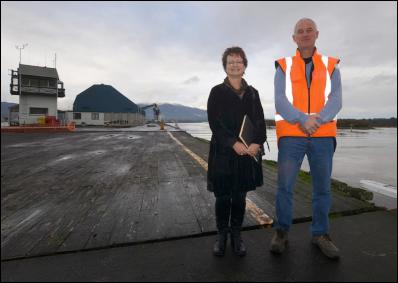
Trish Casey, chief executive of Westport Harbour Limited & Port Manager/Harbourmaster, Mike Graham.
"Our future is under threat with Holcim being our only (significant) shipping customer. (UPDATE 1 August 2013: as this is published news has just come in that Holcim is indeed pulling out of Westport ( " Holcim Invests in Cement Import Terminal" ) .)
Whether we could sustain ownership of the dredge, and dredging activity, on behalf of the council would be debatable. Dredging also has a positive impact in flood protection so there are other benefits of sustaining a deeper port here".
"Inward shipping is also a big opportunity. There’s an incredible amount of fuel brought to the Coast by road transport/ tanker trucks every week (perhaps 60,000 litres going up to Stockton every day alone) that could be substituted by inward shipping. There’s lots of machinery and major pieces of large-sized industrial plant to be transported back and forth too".
In Trish’s words “since setting up here (Bathurst chief executive) Hamish Bohannan has changed the way people are thinking.
"He’s come along and said there’s all that coal there, and there’s a Port right there. Where else in the world do you have that, because in other parts of the world the coal is hundreds, maybe thousands, of miles away from a port".
"We’re sitting and waiting. We’re ready to go. The hold-ups are very frustrating. Not just for us locally, but it's also about people who are prepared to make major investments in New Zealand’s infrastructure and I just wonder how long they can wait. I think a lot of people don’t understand there’s a lot of long-term benefits to be gained".
"A lot of people haven’t been here, they haven’t got any idea. The reason I got involved in Environment West Coast is that so many people don't understand what's at stake".

The mouth of the Buller River as seen from the top of Westport Port's watch house building
(continuing story...)
This story is being published in four parts starting July 31st 2013.
Declaration: Scoop
Amplifier's production, travel and logistical costs to and
from Westport in order to produce this series were paid for
by Buller Coal (owned by Bathurst Resources Limited). A
strict protocol for the purposes of editorial freedom was
agreed. Scoop Amplifier is a business unit of Scoop Media.
Please send feedback on this story to WestportStory@scoop.co.nz




 Ramzy Baroud: Global Backlash - How The World Could Shift Israel's Gaza Strategy
Ramzy Baroud: Global Backlash - How The World Could Shift Israel's Gaza Strategy DC Harding: In The Spirit Of Natural Justice
DC Harding: In The Spirit Of Natural Justice Martin LeFevre - Meditations: Animal Encounters During Meditative States
Martin LeFevre - Meditations: Animal Encounters During Meditative States Ian Powell: Gisborne Hospital Senior Doctors Strike Highlights Important Health System Issues
Ian Powell: Gisborne Hospital Senior Doctors Strike Highlights Important Health System Issues Keith Rankin: Who, Neither Politician Nor Monarch, Executed 100,000 Civilians In A Single Night?
Keith Rankin: Who, Neither Politician Nor Monarch, Executed 100,000 Civilians In A Single Night? Eugene Doyle: Writing In The Time Of Genocide
Eugene Doyle: Writing In The Time Of Genocide